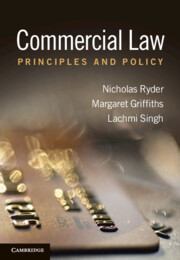Book contents
- Frontmatter
- Contents
- Preface
- List of abbreviations
- Table of Statutory Provisions
- Table of Cases
- Part 1 Agency
- Part 2 Sale of Goods and Services
- Part 3 International Trade and Sales
- Part 4 Tortious Liability for Defective Products
- Part 5 Unfair Commercial Practices
- Part 6 Banking and Finance Law
- Part 7 Consumer Credit
- Part 7 Chapter 1 The Government’s Policy towards Consumer Credit
- Part 7 Chapter 2 The Consumer Credit Act 1974
- Bibliography
- Index
- References
Part 7 Chapter 1 - The Government’s Policy towards Consumer Credit
from Part 7 - Consumer Credit
Published online by Cambridge University Press: 05 August 2012
- Frontmatter
- Contents
- Preface
- List of abbreviations
- Table of Statutory Provisions
- Table of Cases
- Part 1 Agency
- Part 2 Sale of Goods and Services
- Part 3 International Trade and Sales
- Part 4 Tortious Liability for Defective Products
- Part 5 Unfair Commercial Practices
- Part 6 Banking and Finance Law
- Part 7 Consumer Credit
- Part 7 Chapter 1 The Government’s Policy towards Consumer Credit
- Part 7 Chapter 2 The Consumer Credit Act 1974
- Bibliography
- Index
- References
Summary
Introduction
Since the introduction of the first credit card in 1966, the influential recommendations of the Crowther Committee on Consumer Credit (1971) and the introduction of the Consumer Credit Act 1974, creditors now allow debtors to access credit twenty-four hours a day and 365 days a year. The number of creditors and credit products has grown at an unprecedented rate. The evolution of the credit market was hastened by the deregulation of consumer credit legislation in the 1980s and 1990s. This chapter outlines how the relaxation of the consumer credit legislative frameworks resulted in an increase in the availability of ‘convenient credit’, which is defined as ‘credit that is granted by the creditor with little or no reference to the creditworthiness of the debtor’. This chapter identifies several problems that have arisen from access to ‘convenient credit’ (record levels of consumer debt, financial exclusion and over-indebtedness, an increase in irresponsible lending practices and ineffective legislative protection of consumers), which has resulted in a dramatic U-turn by the government towards promoting access to ‘affordable credit’. Affordable credit comprises five basic elements: (i) access to loans that are simple and transparent; (ii) lenders that are sympathetic towards low income consumers’ circumstances; (iii) simple loan application procedures; (iv) small loans over a short period of time; and (v) affordable repayments. The chapter identifies several government initiatives aimed at promoting access to affordable credit, including the creation of the Social Exclusion Unit (SEU), the promotion of credit unions, the development of Saving Gateway and the Financial Inclusion Fund.
- Type
- Chapter
- Information
- Commercial LawPrinciples and Policy, pp. 497 - 521Publisher: Cambridge University PressPrint publication year: 2012



